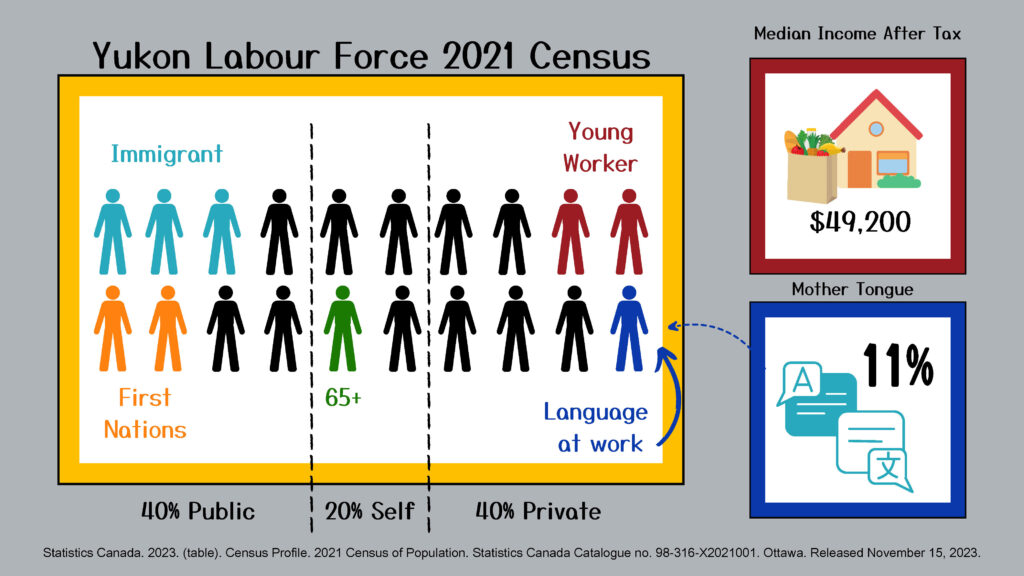
Yukon Labour Market Trends
President Teresa Acheson presented to stakeholders of WSCB and the WSCB Board of Directors on January 30th, 2024 as part of their strategic planning for the next few years. This outlines the challenges and opportunities ahead from the perspective of the Yukon Federation of Labour.
Current labor market trends in Yukon
- Increased Demand in Various Sectors: There is a notable demand for workers in most sectors, particularly mining, tourism, healthcare, and construction, leading to higher job vacancies in these areas.
- Changing Workplace Demographics: There is a skilled labour gap left by retiring experienced workers, the influx of young workers as well as immigrant workers. Workplaces are also changing as more indigenous ways of learning are embraced and First Nations governments evolve.
- Remote Work and Flexible Arrangements: Remote work and flexible work arrangements are altering the traditional landscape of employment, requiring adaptation of safety training methods and context. This elevates the importance of worker well-being, mental health support, and work-life.
- Economic Growth Impact: The overall economic growth in Yukon is influencing labor market trends, with new projects and investments contributing to shifts in employment demands and opportunities.
These trends are shaping the labor market in Yukon, influencing job availability, skill requirements, and the nature of work arrangements.
Considerations for the Future of Work
- Labor Market Resilience: Addressing the resilience of the labor market in the face of economic changes, emphasizing strategies for navigating uncertainties and leveraging opportunities.
- Worker Representation: Ensuring worker representation and advocacy in discussions related to safety initiatives and their impact on the labor landscape.
- Adapting to Technological Shifts: The impact of automation and AI applications presents challenges and opportunities for workers, requiring a balance between technological advancement and worker well-being, addressing potential job displacement, and the need for upskilling and reskilling.
- Worker-Centric Technological Adoption: Advocating for the adoption of technologies that prioritize worker well-being, safety, and empowerment, fostering a worker-centric approach including equipping workers with digital skills and competencies to thrive in the digital work landscape.
For example, the Pembina Institute recently released a 2-part report on a modeling exercise undertaken that mapped two diverging trajectories to net-zero by 2050: one with additional supports for workers, and one without. The model suggests that a modest set of interventions prevents higher unemployment among exposed workers, greater regional disparities, and lower GDP. Interventions can keep workers in their home provinces and ensure they continue to contribute to their local economies.
https://www.pembina.org/pub/sustainable-jobs-blueprint

Current Labour Force Statistics
In the past year alone, the labour force increased by 1500, compared to just a 400 increase between 2021-2022. Yukon has the lowest unemployment rate across Canada and the highest participation rate (The participation rate measures the percentage of the population aged 15 years and over, working or actively looking for work.) These are signs of a healthy and robust workforce but it also means we tend to see higher job vacancy rates which can impact workers and the workplace’s ability to address safety proactively. The Yukon labour force has also seen increasing immigration and expanding markets.

The Yukon labour force is over 25,000. According to STATS Canada 2021 Census, for every 20 workers:
- There are 3 Immigrant workers, 2 young workers (age 15-24), 1 over 65, 2 First Nation workers, and 1 worker who primarily uses a non-official language at work.
- Our workforce is approximately 40% public, 40% private, and 20% self-employed. According to instructors at Northern Safety Network Yukon, 80% of the participants are from small employers, and the remainder are from very large employers, which means processes need to be adaptable for very large and very small employers.
- The median income after tax in Yukon was $49,200. Considering the current cost of living, this means many workers can be in precarious positions, carrying stress with them into the workplace.
- 4,705 Yukoners have a non-official language as their mother tongue (11% of those in the census). This is significant when you consider how this impacts workers’ understanding of safety policies, procedures, and rights distributed primarily in English.
Challenges for Worker Safety & Well-being
The Yukon Federation of Labour identifies 4 evolving challenges facing the Yukon labour market:
- Major Shifts in Work: Transition to sustainable jobs, remote work, and flexible arrangements necessitating policy and practice adaptation.
- Adapting to New Work Environments: Adapting to changing work environments, including remote work, AI, climate change, and sustainability legislation pushes for a new look at worker safety standards, mental health and well-being initiatives, and the need for upskilling and reskilling the workforce.
- Application of Legislation: challenge to provide opportunities for workers to practice safety protocols and demonstrate their proficiency and ensure external audits to confirm compliance of employers.
- Workforce Expansion: Recent exponential growth in population including an increase in immigration should trigger changes to the supports and resources available in the territory for workplace safety and worker injuries. (eg. Safe Work resources in multiple languages in MB and NB)
Opportunities for Worker Safety & Well-being
- Opportunities for Innovation: The changing landscape presents opportunities for innovation, skill development, and the creation of new job roles, that create more sustainability in the Yukon. And we can address the need for seamless pathways and support. (eg. Is this WSCB, Workers Advocate, YHRC, Employment Standards, Federal, ACSB)
- Strategic Skill Development: Opportunities exist for enhanced training and skill development programs to equip workers with the competencies needed for the evolving labor landscape and address the skilled labour shortage. Promoting digital literacy and inclusion to bridge the digital divide and ensure that all workers can participate meaningfully in the evolving labor landscape.
- Collaborative Initiatives: Collaborative efforts between the federation, employers, and regulatory bodies are crucial to address emerging safety and well-being challenges in the modern work environment.
- Inclusive Culture: Addressing inclusivity and diversity in the labor market, incorporating reconciliation, ensuring equal opportunities and fair treatment for all workers.
Planning for a Safe Future
At the 2022 YFL Convention, resolutions were passed on inclusive language, national pharmacare, training and wage benefits for healthcare staff, medicare in the north, affordable housing for workers, and investigating a Worker Action Centre for the Yukon. These resolutions determine the priorities for the Yukon Federation of Labour for 2023-2025. A number of these have a bearing on the future of safe workplaces and the recovery of injured workers.
A Worker Action Centre could assist with labour rights advocacy, community engagement, safety awareness and support, and educational initiatives to address labour market needs. A needs analysis indicates that new to Yukon, new to Canada, and young workers are at higher risk and would benefit most from targeted support and education in workplace safety.







